Calculate how many panels you need
A complete guide to calculating the right solar panel system size for your property and determining how many panels you need.
Your system size results
Disclaimer
This solar system size calculator is indicative only. It is provided to give you a general guide of the right system size based on your inputs.
An introduction to solar system size
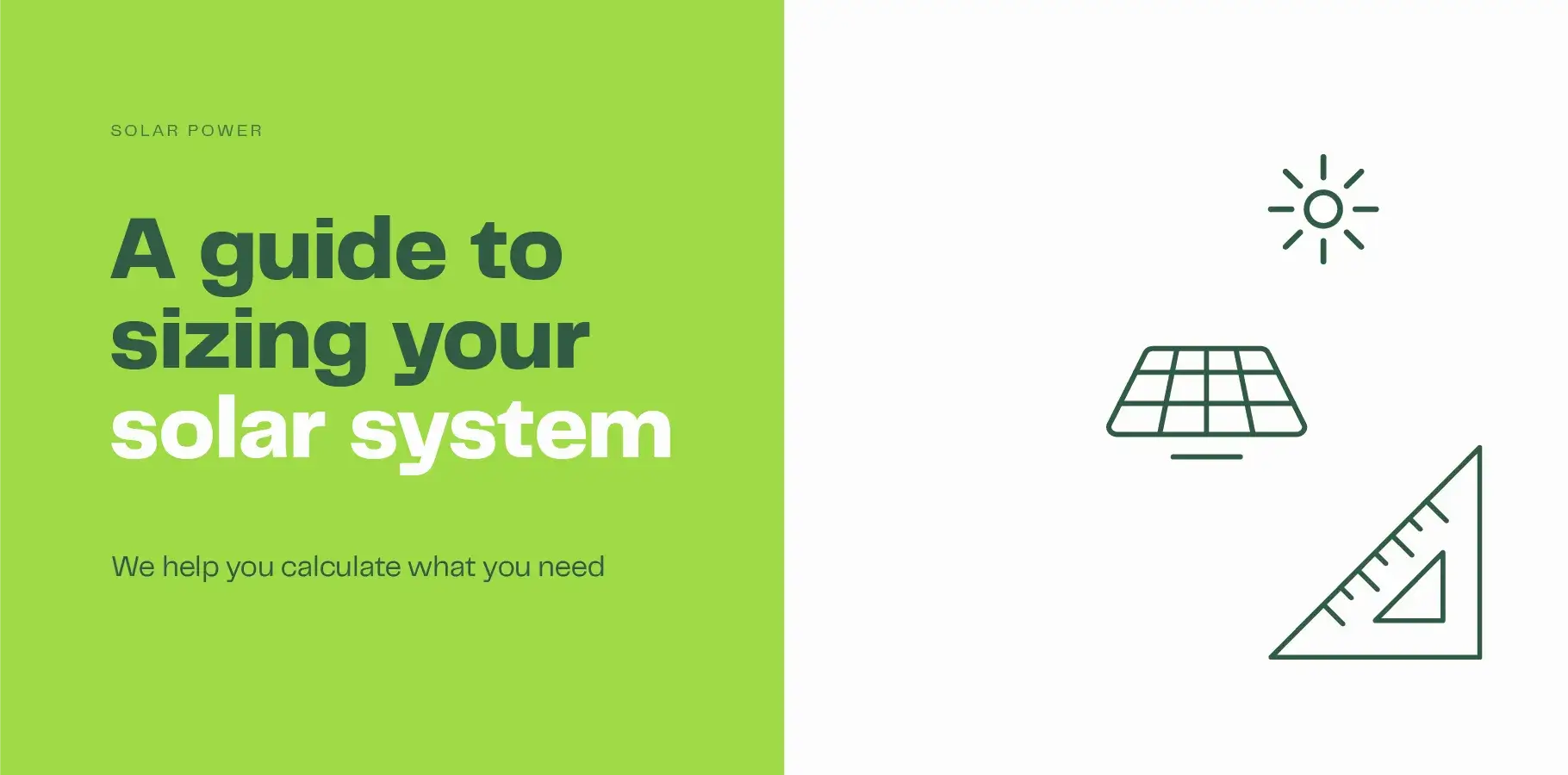
If you’re thinking of going solar, one of the first questions you might have is, “How many solar panels do I need?”
How many panels you need depends on the size of the system you plan to install. A different number of panels can make up the same size system.
For example, a 6.6kW system can be made up of anywhere between 15 - 20 panels. This number of panels is typically enough to power the average Australian home. However, there is much to consider; we explain why bigger is better if you can afford it and, the importance of understanding your future energy needs.
Getting your system size right depends on six individual factors:
- 1. Sun exposure at your property
- 2. Your electricity consumption
- 3. Your budget
- 4. Your available roof space
- 5. Are you planning to get a solar battery
- 6. Your future energy plans
This article will take you through how to use our Solar System Size Calculator. We’ll also explain everything you need to know when deciding how many solar panels will be enough to power your home, with or without the help of our calculator.
Understanding solar panel size
The size of a solar panel can refer to two different things:
- The power output of the solar panel (measured in Watts)
- The physical size dimensions of the panel
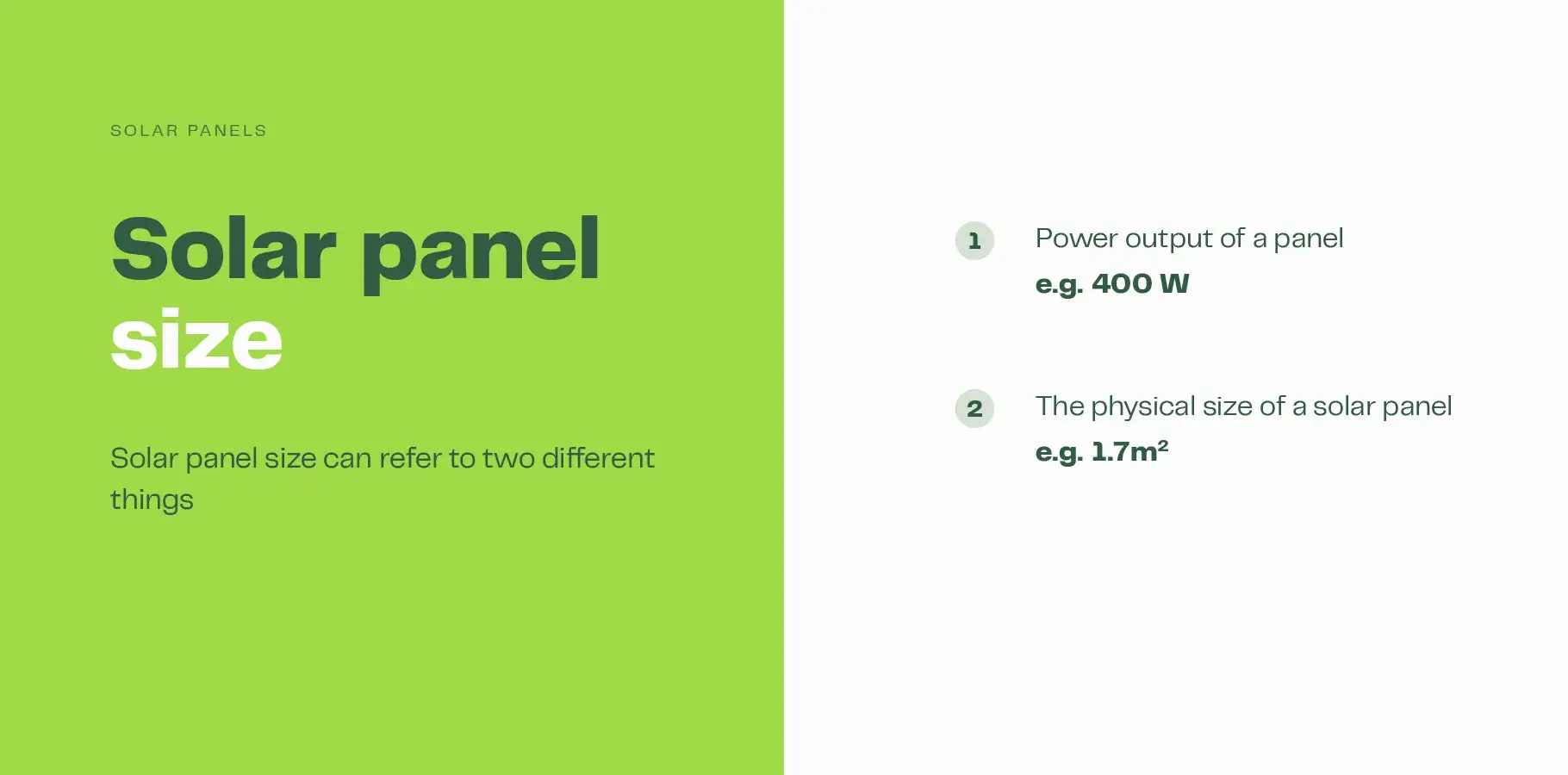
Solar panel power output
The size of a solar panel system is measured in kilowatts (kW). Each solar panel has a rated capacity of how much power it can generate in ideal conditions, measured in watts (W) e.g. 400W. This capacity of is often referred to as the solar panel size.
One kilowatt is equal to 1,000 Watts.
If a system is made up of 15 x 400W panels, then the total system size is 6kW.
Energy produced by different system sizes
Energy produced by solar panels is measured in kilowatt-hours (kWh). Likewise, your electricity consumption is measured in kilowatt-hours – a measurement of energy as opposed to the power capacity (kW) of a solar panel.
If you run an electrical appliance e.g. a 3.5kW air conditioner for one hour, it will use 3.5 kWh of electricity.
The table below shows the energy produced by different size solar panel systems in each Australian state:
| State | System size | Energy produced (kWh) |
|---|---|---|
| VIC | 3kW | 10.8 |
| VIC | 5kW | 18.0 |
| VIC | 6.6kW | 23.8 |
| VIC | 8kW | 28.8 |
| VIC | 10kW | 36.0 |
| VIC | 13kW | 46.8 |
| State | System size | Energy produced (kWh) |
|---|---|---|
| NSW | 3kW | 11.7 |
| NSW | 5kW | 19.5 |
| NSW | 6.6kW | 25.7 |
| NSW | 8kW | 31.2 |
| NSW | 10kW | 39.0 |
| NSW | 13kW | 50.7 |
| State | System size | Energy produced (kWh) |
|---|---|---|
| QLD | 3kW | 12.6 |
| QLD | 5kW | 21.0 |
| QLD | 6.6kW | 27.7 |
| QLD | 8kW | 33.6 |
| QLD | 10kW | 42.0 |
| QLD | 13kW | 54.6 |
| State | System size | Energy produced (kWh) |
|---|---|---|
| SA | 3kW | 12.6 |
| SA | 5kW | 21.0 |
| SA | 6.6kW | 27.7 |
| SA | 8kW | 33.6 |
| SA | 10kW | 42.0 |
| SA | 13kW | 54.6 |
| State | System size | Energy produced (kWh) |
|---|---|---|
| WA | 3kW | 13.2 |
| WA | 5kW | 22.0 |
| WA | 6.6kW | 29.0 |
| WA | 8kW | 35.2 |
| WA | 10kW | 44.0 |
| WA | 13kW | 57.2 |
| State | System size | Energy produced (kWh) |
|---|---|---|
| TAS | 3kW | 10.5 |
| TAS | 5kW | 17.5 |
| TAS | 6.6kW | 23.1 |
| TAS | 8kW | 28.0 |
| TAS | 10kW | 35.0 |
| TAS | 13kW | 45.5 |
| State | System size | Energy produced (kWh) |
|---|---|---|
| ACT | 3kW | 12.8 |
| ACT | 5kW | 21.3 |
| ACT | 6.6kW | 28.1 |
| ACT | 8kW | 34.1 |
| ACT | 10kW | 42.6 |
| ACT | 13kW | 55.4 |
| State | System size | Energy produced (kWh) |
|---|---|---|
| NT | 3kW | 13.2 |
| NT | 5kW | 22.0 |
| NT | 6.6kW | 29.0 |
| NT | 8kW | 35.2 |
| NT | 10kW | 44.0 |
| NT | 13kW | 57.2 |
Solar panel size dimensions
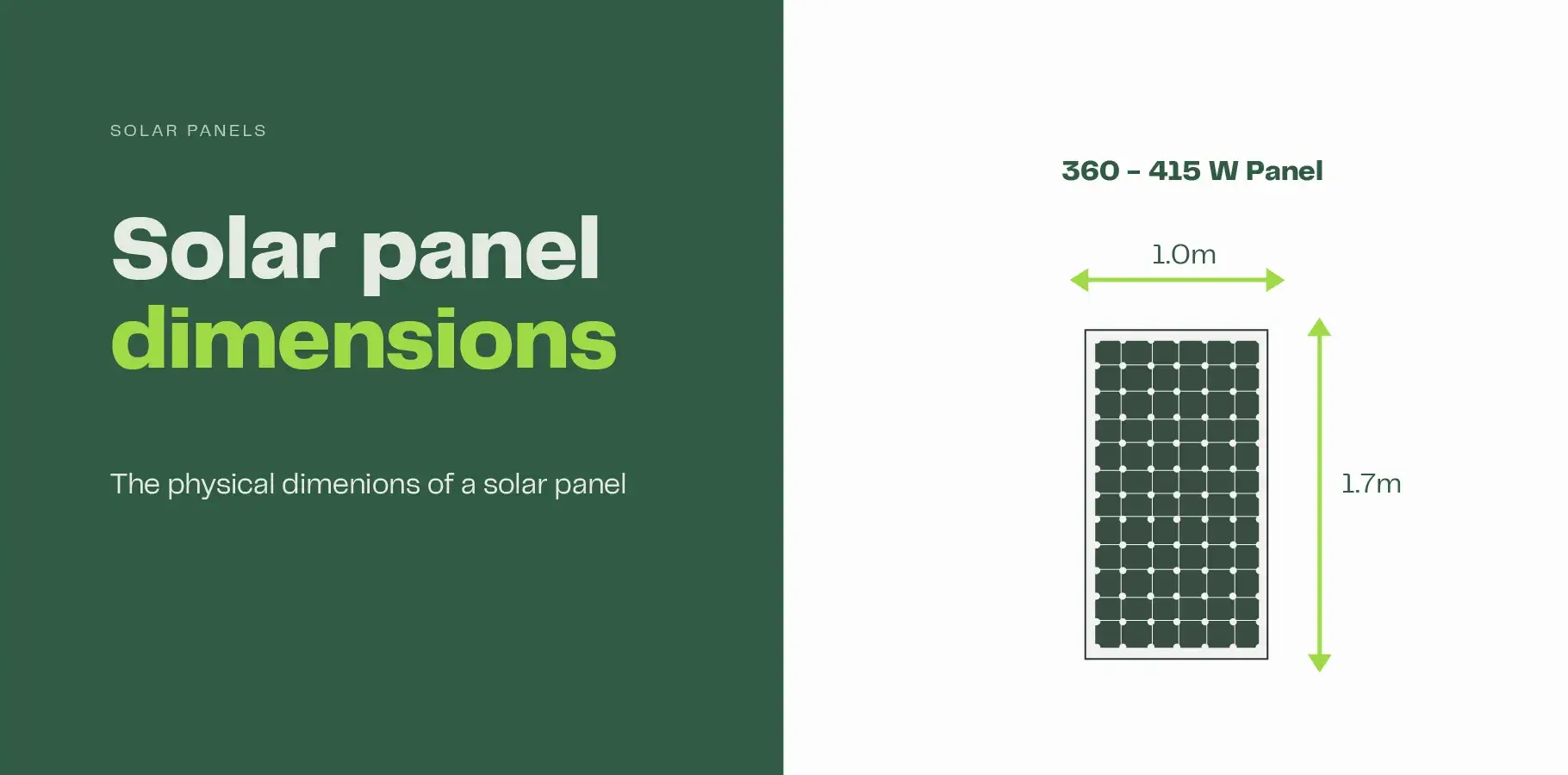
It’s also important to understand the physical size dimensions of solar panels so that you can calculate how many panels you can fit onto your roof.
The typical household panel comes in the standard width and length dimensions of 1.70m x 1.00m (170cm x 100cm). The depth, or thickness, of solar panels varies with the manufacturer, but is typically between 30mm – 40mm.
Standard panel dimensions
| Width | length | Thickness |
|---|---|---|
| 100cm | 170cm | 3cm - 4cm |
Applying the 1.0m x 1.7m standard dimensions, every panel requires 1.7m2 of roof space. For the 15 x 400W panel 6kW system in our earlier example, you would need 25.5m2 of roof space. The roof area required will change if the power output wattage size of the panel is different. For example, if your system is made up of 17 x 350W panels, you’ll need 28.9m2 of space on your roof.
Important note: Not all solar panels are exactly the same size. Some panels are slightly longer at 1.8m.
Commercial solar panels are bigger
Commercial solar panels are typically larger and consist of 72 cells as opposed to the 60 cells of domestic panels. Standard commercial solar panel dimensions are 100cm x 195.5cm. Being larger, their power output is also higher.
Solar panel weight
As a guide, each domestic solar panel typically weighs between 18 – 23 kgs. Though the exact weight varies by manufacturer, as evidenced in the table of high-performing panels below:
| Brand | Power output (W) | Weight |
|---|---|---|
| REC Alpha Pure R | 420 | 21.5 kg |
| SunPower Maxeon 3 | 430 | 21.2 kg |
| Longhi Hi-MO X6 | 420 | 22.5 kg |
| Trina Vertex X | 435 | 21.8 kg |
Most household rooftops can withstand the weight of a solar panel system.
How to calculate your optimal solar system size
We take you through the steps to calculate the ideal system size for your property.
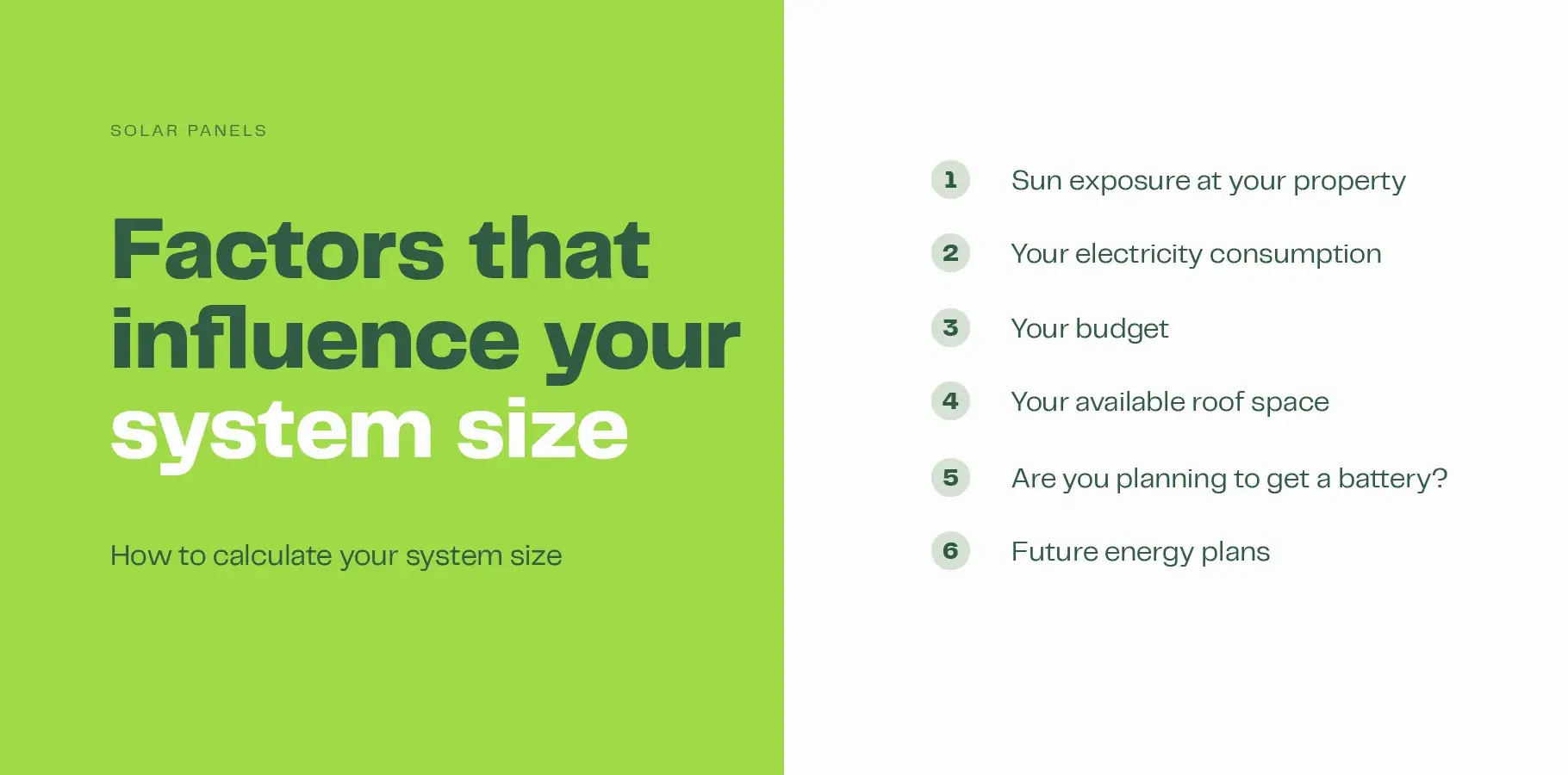
Sun exposure at your property
The first step is to calculate how much sunlight hits your rooftop where your solar panels will be positioned. Your postcode is important here, because our calculator will draw on the nearest weather station data to your location.
Once we have the data on sunlight hours, we then need to consider limiting factors that impact the electricity output of the solar panels on your roof, these include:
- Roof orientation
- Roof angle
- Shading or obstruction
Roof orientation
Solar panels will generate more power if you can install them on a roof that faces north. If your roof’s orientation is east or west, that’s ok too.
Roof angle
Solar panels are typically installed on the same angle of your roof unless it is flat. If the angle of your roof is less than 10°, it will start to impact your system’s output.
Shading and obstruction
If your rooftop is shaded, or obstructed by another building, this will impact on the system’s output.
Your electricity consumption
The next piece of information we need is how much electricity your house consumes on a daily basis. You can find this information on your electricity bills, or failing that, you can use this electricity use calculator.
Electricity use is measured in kilowatt-hours (kWh). As a guide, the average Australian household uses between 16 – 18 kWh of electricity per day.
Daytime electricity use
You also need to estimate your electricity use during daylight hours. Knowing this, tells you how much electricity you will be able to self-consume once your solar system is up and running.
Your budget
Your budget is also a factor. If you cannot afford, or do not want to buy a 5 or 6.6kW solar system, then we recommend sizing your system so that it can cover your daytime electricity use.
Before you let budget constraints impact your system size, check to see if there are any additional solar panel rebates available in your state or local council zone.
System size based on daylight electricity use
Let's work through a calculation based on daytime electricity use.
The average Australian household consumes 18 kWh of electricity each day. If we use a house in Adelaide as an example, you would need a 5kW solar system to generate enough energy to offset electricity consumption. However, if the household only consumes 40% (7.2 kWh) of its electricity during daylight hours, such a large system may not be necessary.
In this case, a 3kW system that generates on average 12.6 kWh of electricity per day would be sufficient and, would provide the most affordable solution.
If the upfront cost of solar is an issue, you may consider financing the purchase with a solar loan.
Your available roof space
How much roof space you have is really important in determining how many panels you need. If you cannot fit the system size that you want onto your roof, you’ll need to select a smaller installation or higher rated panels.
The greater the panel efficiency, the higher the power output of the panel. The higher the power output, the less panels you will need.
For example, A 6.6kW solar system might use 20 x 330W panels, or 15 x 430W panels.
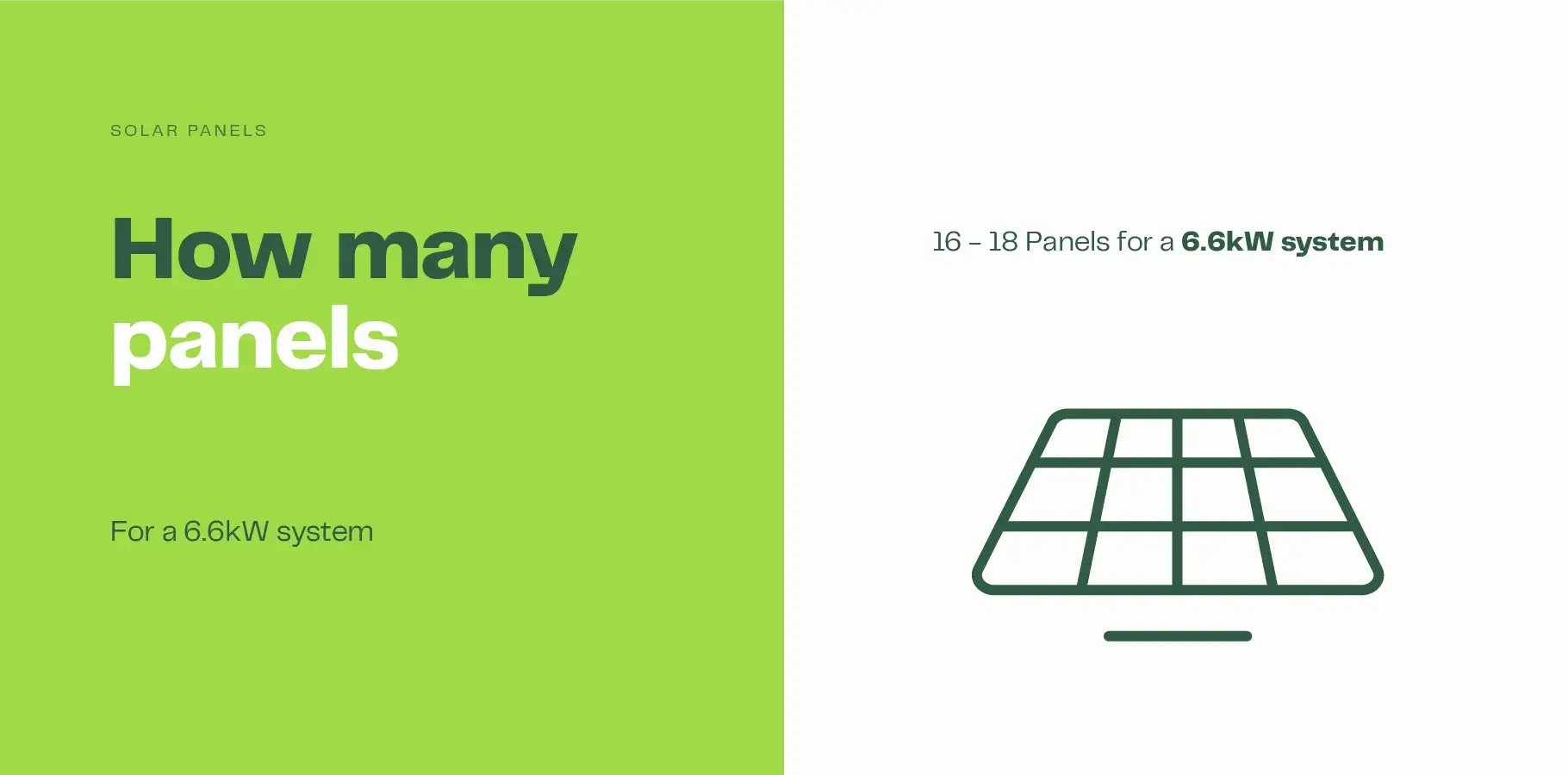
The table below shows the number of panels and roof area required for different system sizes:
Number of panels and roof area required per system size
| System size | Number of panels | Roof area required |
|---|---|---|
| 3kW | 7 - 9 | 11.9 - 15.3m2 |
| 5kW | 12 - 15 | 20.4 - 25.5m2 |
| 6.6kW | 15 - 20 | 25.5 - 34m2 |
| 8kW | 19 - 24 | 32.3 - 40.8m2 |
| 10kW | 24 - 30 | 40.8 - 51m2 |
| 13kW | 30 - 40 | 51 - 68m2 |
Do you plan to buy a solar battery?
Consider whether you plan to add a solar battery to your solar system either now or in the near future. If you do get a battery, you will need enough solar panels to directly power your appliances during the day and charge your battery, so that you can use that stored solar power at night.
If you don’t plan on getting a battery, it’s likely that your system size will be smaller.
How a battery impacts system size
Let's use the example of a household in Brisbane to show how adding a battery increases the system size. For this example, we assume:
- Average daily electricity use = 25 kWh
- Average daily daylight hours use = 10 kWh
- Future electricity use is not increasing
A 6.6kW system is large enough to cover the daily electricity use, as it will produce an average of 28 kWh per day. The table below shows where that 28 kWh goes:
| Where solar energy goes | Amount (kW)h |
|---|---|
| Solar self-consumption (daylight use) | 10 kWh |
| Charging solar battery | 15 kWh |
| Excess sent to grid | 3 kWh |
If the household didn't plan to get a solar battery, then they do not need as many panels. They would only need a system size large enough to comfortably power their 10 kWh of daylight electricity use. A 3kW system may do this.
However, it's wise to upsize the system where possible, it may be that a system size of 4.5kW provides the best solution.
Future energy plans
If you buy a good quality solar panels, you can expect them to last well over 20 years. That’s why it’s important to consider your future energy plans.
More and more households are seeking to electrify their energy needs, so that they can be powered by renewable energy. Doing so, will likely increase the amount of electricity you use. So, consider the following, are you planning to:
- Buy an electric vehicle (EV)?
- Switch gas appliances over to electric?
- An extension to your house?
- Install a pool or add pool heating?
Even if you feel you are not likely to do any of the above in the near future, consider what type of car you will buy next. Will it be electric? If so, then you will want a solar panel and battery system to power your EV, rather than the electricity grid.
Your calculator results
Our system size calculator considers all of your inputs before displaying an appropriate size system.
Payback, savings and reducing emissions
Your goals for installing solar panels also impact the size and type of the system you install.
Consider savings and payback period
If your goals are purely financial, the cost, savings and payback are likely to influence your system size decision.
If this is the case, we recommend using our solar savings calculator. It lets you play around with different system sizes, using a toggle, to see the impact they have on the upfront cost, annual savings, payback period and your carbon emissions.
It also tells you how many panels you need based on that system size.
Get accurate savings and payback figures for solar panels
Reduce your electricity bills. Cut your emissions.
Offsetting home energy use
A goal for many solar owners is to offset their electricity use. With average electricity consumption around the 18kWh / day level, typically a 5kW or 6.6kW system is large enough.
However, gas consumption is not included in the daily energy use figures. With the move away from gas towards household electrification and electric vehicles, electricity consumption is expected to rise significantly.
Rewiring Australia estimates that the average fully electrified household will use around 37kWh of electricity per day 1. Powering all of this electricity will require a 10kW - 13kW solar panel system.
Reducing your household emissions
If your goal is to reduce your household emissions as much as possible, then try and fill your roof with solar! Go for as large a system as is feasible.
The benefits of a larger system
If you have the roof space and the finances, we recommend choosing a larger system size.
Some benefits of a larger size system include:
- Cost economy
- Feed-in tariff credits
- Better value per kW
- Panels don't produce as much electricity in winter
Cost economy
No matter what system size you choose, the labour time represents a significant portion of the overall cost. Once the initial installation tasks are complete, adding more panels doesn’t add that much extra labour.
In addition, larger inverters and extra panels often come at a comparatively lower cost.
Feed-in tariff credits
Selecting a larger system means you will be better rewarded for the excess energy you export back to the grid.
Better value per kW
When looking at the cost of solar panels, larger systems often have a lower price per kilowatt. So, if you choose a bigger system, you might get more power for your money.
Take for example the price in Sydney for 3kW and 5kW solar systems:
| System size | System price | Price per kilowatt (kW) |
|---|---|---|
| 3kW | $4,223 | $1,407 |
| 5kW | $5,538 | $1,107 |
When looking at the system price in this example, you pay only $657 per extra kW to upgrade from 3kW to 5kW. This evens out to a difference of $300 per kW.
Panels don't produce as much electricity in winter
When sizing a solar system, you should consider how much electricity your solar panels will generate in winter months.
Solar production decreases in winter months due to lower sunlight hours because of the shorter days. Exactly how much lower solar yields are depends on your location.
Let’s take a look at the effect that reduced winter generation has on system sizes in Melbourne.
Electricity use:
Daily electricity = 18 kWh (Australian average)
Daylight use = 7.2 kWh (Assume 40%)
The output of a 5kW system:
Average daily output = 18 kWh
Winter daily output = 9.0 kWh
In this example, a 5kW system will produce enough electricity in winter to power the daylight usage of 7.2 kWh. A smaller system would not be able to generate enough electricity to power the household’s daylight energy use in winter.
Maximum system size limits
Depending on where you live, there may be limits that affect the maximum size of the system you can install. These limits are set by your electricity network provider and not your electricity retailer.
The export limits are put in place to restrict the amount of electricity you can export to the grid. Technically, the limit is placed on the inverter and not the system size. In some cases, export limits are as low 5kW.
Inverter sizing
The size of your inverter does not always need to match the size of your panel system. Often, an installer may pair your solar panels with a slightly smaller size inverter. The reason they do this is because the panels rarely operate at their rated power output capacity.
For example, it is possible to install a 6.6kW system with a 5kW inverter.
3-Phase power affords you a higher limit
If you have a 3 -Phase power connection, you typically have a higher export limit. Export limits are applied to each phase, so if there is a 5kW inverter limit, you can install a system with a 15kW 3-Phase inverter and effectively triple the system size allowed on a single phase connection.
This resource can help determine what size inverter you can install at your property.
Want to talk to an expert installer about export limits?
Get 3 free quotes from our accredited partners today.
Terms explained
Kilowatt (kW)
A kilowatt (kW) is a unit that measures how much power a solar system can produce. One kilowatt is equal to 1,000 Watts.
Kilowatt hours (kWh)
A kilowatt-hour (kWh) is unit that measures how much energy a solar system can produce per hour.
Solar system size
Solar system size is a measure of the power capacity of a solar panel system. To measure system size, you simply add up the wattages of all the solar panels in the system. A system comprising twenty 400-watt solar panels has a system size of 8kW.
Wattage output
Wattage output is the amount of power a solar panel can produce in ideal conditions. It is measured in watts (W) and represents the system's capacity to generate energy.
Next steps
Our Solar Power Size Calculator is a great way to help you understand your ideal system size. With this information now at hand, here are some next steps you can take.
- Learn more about solar system sizes, with our guides to 3kW systems, 5kW systems, 6.6kW systems, 10kW systems and 13kW systems.
- You can read up on average solar panel prices for your system.
- Read our complete guide to getting solar for your home.

Are you ready for the benefits of solar?
Get 3 free quotes and start your journey towards making the switch.
Get free quotes